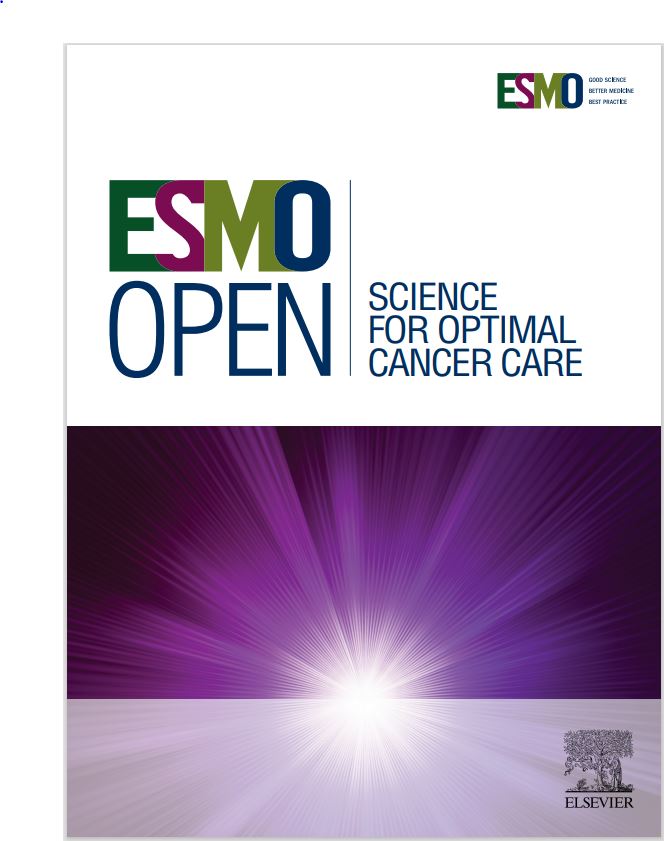A phase II study of monalizumab and durvalumab in patients with recurrent/metastatic squamous cell carcinoma of the head and neck: results of the I2 cohort of the EORTC-HNCG-1559 trial (UPSTREAM)
IF 7.1
2区 医学
Q1 ONCOLOGY
引用次数: 0
Abstract
Background
Monalizumab (M), targeting the natural killer group 2A (NKG2A) receptor, has limited activity as monotherapy in recurrent/metastatic (R/M) squamous cell carcinoma of the head and neck (SCCHN). Preliminary data of M and durvalumab (D) have shown encouraging activity in other tumor types.
Patients and methods
The UPSTREAM trial was an umbrella trial of targeted therapies and immunotherapy for R/M SCCHN. The immunotherapy 2 (I2) cohort was a phase II, randomized, open-label substudy evaluating the efficacy of D + M versus physician’s choice (control). Patients non-eligible for the biomarker-driven cohorts and pretreated with PD(L)1, were included in the I2 cohort. The primary endpoint was the objective response rate (RECIST version 1.1) during the first 16 weeks.
Results
Sixty-six patients with R/M SCCHN were included in the I2 cohort, of whom 60 were assessable (D + M: n = 42, control: n = 18): median age 62 years; 87% with two or three previous lines of treatment. In the D + M arm, one partial response (PR) was recorded, and stable disease (SD) was observed in 11 (26%). One PR was reported in the control arm and SD in 8 (44%). The median progression-free survival (PFS) was 2.0 and 3.1 months in the D + M arm and control arm, respectively. The median overall survival (OS) was 4.3 months (95% confidence interval 3.3-8.9 months) and 8.0 months (95% confidence interval 3.1-14.9 months) in the D + M and control arms, respectively. In the D + M arm, 4 (9%) patients reported grade ≥3 treatment-related adverse events.
Conclusion
The I2 substudy failed to demonstrate an activity of D + M in heavily pretreated patients with SCCHN previously exposed to anti-PD(L)1. No benefit was seen in PFS and OS.
单抗和杜伐单抗在头颈部复发/转移性鳞状细胞癌患者中的II期研究:EORTC-HNCG-1559试验I2队列的结果(UPSTREAM)
背景:monalizumab (M)靶向自然杀伤组2A (NKG2A)受体,作为单一疗法治疗复发/转移性(R/M)头颈部鳞状细胞癌(SCCHN)的活性有限。M和durvalumab (D)的初步数据在其他肿瘤类型中显示出令人鼓舞的活性。患者和方法UPSTREAM试验是一项针对R/M SCCHN的靶向治疗和免疫治疗的综合试验。免疫疗法2 (I2)队列是一项II期、随机、开放标签的亚研究,评估D + M与医生选择(对照组)的疗效。不符合生物标志物驱动队列和PD(L)1预处理条件的患者被纳入I2队列。主要终点是前16周的客观缓解率(RECIST 1.1版)。结果I2队列纳入66例R/M型SCCHN患者,其中60例可评估(D + M: n = 42,对照组:n = 18):中位年龄62岁;87%的患者接受过两次或三次治疗。在D + M组中,记录到1例部分缓解(PR), 11例(26%)观察到疾病稳定(SD)。对照组1例PR, SD 8例(44%)。D + M组和对照组的中位无进展生存期(PFS)分别为2.0和3.1个月。D + M组和对照组的中位总生存期(OS)分别为4.3个月(95%可信区间3.3-8.9个月)和8.0个月(95%可信区间3.1-14.9个月)。在D + M组中,4例(9%)患者报告了≥3级治疗相关不良事件。结论I2亚组研究未能证明在先前暴露于抗pd (L)1的重度预处理的SCCHN患者中D + M的活性。在PFS和OS中没有看到任何益处。
本文章由计算机程序翻译,如有差异,请以英文原文为准。
求助全文
约1分钟内获得全文
求助全文
来源期刊

ESMO Open
Medicine-Oncology
CiteScore
11.70
自引率
2.70%
发文量
255
审稿时长
10 weeks
期刊介绍:
ESMO Open is the online-only, open access journal of the European Society for Medical Oncology (ESMO). It is a peer-reviewed publication dedicated to sharing high-quality medical research and educational materials from various fields of oncology. The journal specifically focuses on showcasing innovative clinical and translational cancer research.
ESMO Open aims to publish a wide range of research articles covering all aspects of oncology, including experimental studies, translational research, diagnostic advancements, and therapeutic approaches. The content of the journal includes original research articles, insightful reviews, thought-provoking editorials, and correspondence. Moreover, the journal warmly welcomes the submission of phase I trials and meta-analyses. It also showcases reviews from significant ESMO conferences and meetings, as well as publishes important position statements on behalf of ESMO.
Overall, ESMO Open offers a platform for scientists, clinicians, and researchers in the field of oncology to share their valuable insights and contribute to advancing the understanding and treatment of cancer. The journal serves as a source of up-to-date information and fosters collaboration within the oncology community.
 求助内容:
求助内容: 应助结果提醒方式:
应助结果提醒方式:


